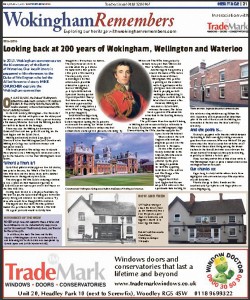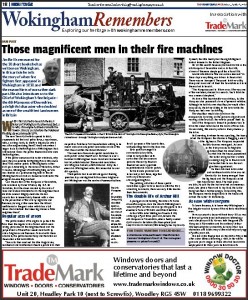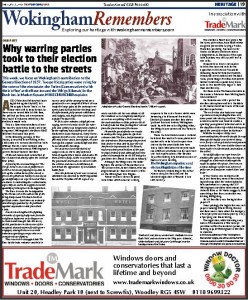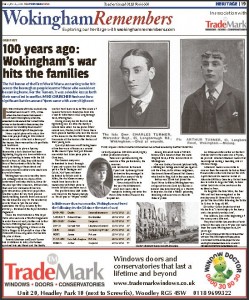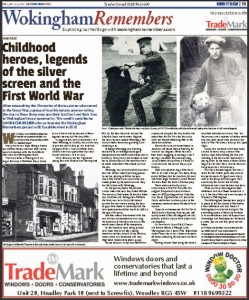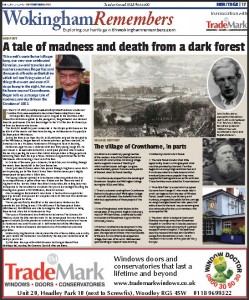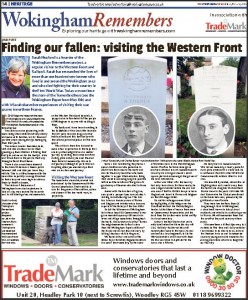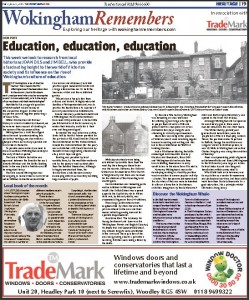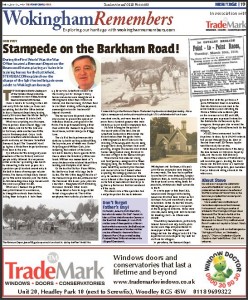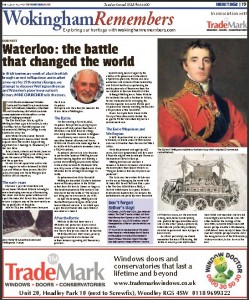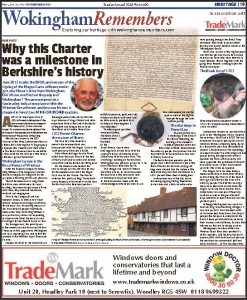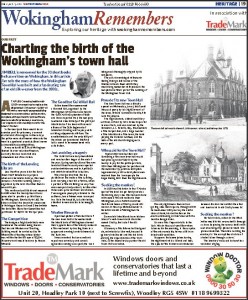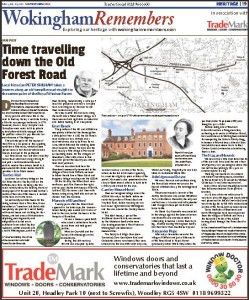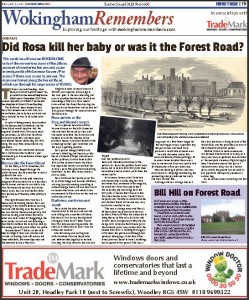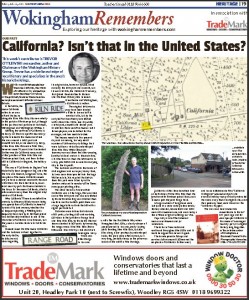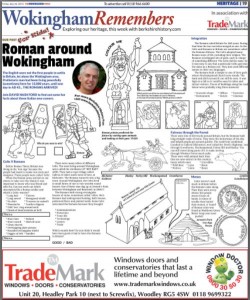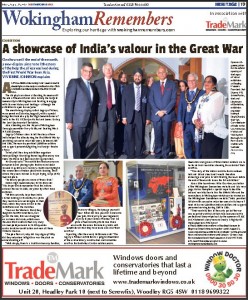A heritage page was launched in March 2015 with the title Wokingham Remembers with the objective of telling the Wokingham story as an area and not just the town of the same name. Local historians have given their time without charge in support of the newly launched paper along with a local business, the well-known community supporter ‘Trademark Windows’. Online support for the printed page is provided by Wokingham Remembers.com.
As we reach the end of the page’s first Summer Season, a review of the articles is provided below to give an overview of what are effectively pieces of the Wokingham jigsaw.
27th March 2015: 200 years of Wokingham Wellington and Waterloo.
The inaugural issue of Wokingham Remembers discusses the influence of Waterloo on the local community pointing to pubs and roads and how they are connected to the battle. There is also the opportunity to show how history can be skewed by emotions and patriotism; the Dukes Head pub shows the face of Wellington, but the pub was named well before he was given the title of Duke. The pub was more likely to be titled after the Duke of St Albans, a Lord Lieutenant. The objective of the article was to commemorate Waterloo’s bicentenary and start the story of Wokingham’s proud history – something not well known to today’s populace. Author and editor: Mike Churcher.
24th April 2015 – Those Magnificent Men in their Fire Machines.
Following the trial the ‘Paper’ started its regular weekly spot with the story of the extraordinary 6th Marquess of Downshire, one of the UK’s wealthiest men of his day and also the chief of Wokingham’s Fire Brigade. A man at ease as much with travellers of the road as he was with royalty, Arthur Hill exemplified the era of the benefactors who helped build the infrastructure of Wokingham’s community. The story includes some fascinating anecdotes of the man himself. Author: Jim Bell Editor: Mike Churcher
1st May 2015 – Why warring parties took their election battle to the streets.
We start to present a picture of Wokingham’s (and the nations) traditional dual personality. On the one hand it is led by an educated elite and gentry, but there existed to, a scurrilous even ‘chippy’ rural populous. This story is about the 1857 General Election and the riot which took place in Wokingham’s town centre. Particularly interesting is the hint that such brawling happened on a regular basis and the election was just a convenient backdrop. We also use this story to illustrate the corruption of the early elections and the development of the secret ballot. A theme which will run throughout these articles will be the comparison between local history and what was happening on the national stage at the time. Author: Mike Churcher. Original source: the unpublished sketches of Arthur T Heelas
8th May 2015 – 100 years ago: Wokingham’s War hits the families.
Between 2014 and 2018 there will be regular commemorations of certain battles from World War One.
During May 1915 the battle of Ypres was raging and we list the men from Wokingham’s Town Hall Memorial who had been killed between August 1914 and May 1915.
We tell the story of two brothers from Langborough Road Wokingham who were killed during the war. Author and editor: Mike Churcher Research: Sarah Huxford
15th May 2015 – Childhood heroes, legends of the silver screen and the First
World War. This article has a part reminiscence theme to it, whereby it works on the readers own memory whilst also illustrating how apparently disconnected themes can suddenly tie together.
We all know Winnie the Pooh, Lassie and probably Rin Tin Tin, but what was their true story and how did they link up with the Great War?
The story is told as if sitting in the old Wokingham Electric Theatre opened in 1913.
To read this article you will need to bring along a drink and a box of popcorn. Author and editor: Mike Churcher
22nd May 2015 A tale of madness and death from the Dark Forest.
Historian Roger Long is well known for his tales from the dark side of Berkshire; of murder, madness and things that go bump in the night. We selected this story for a number of reasons which whilst focuses on the story of one man, it presents us with a bigger picture of the area.
Firstly, we are introduced to the notion that the area around Wokingham was both heathland and heavily wooded and a part of the Windsor Royal Forest. We introduce too the village of Crowthorne and its connection with the Broadmoor Asylum for the Criminally Insane. Roger cleverly weaves the story of a mad preacher in the forest with the story of Broadmoor, which still houses many of Britain’s dangerous, mentally ill patients. Author: Roger Long. Editor: Mike Churcher
29th May 2015. Finding our Fallen: visiting the Western Front. This article was aimed at local people using the fine Spring weather to take a trip over to the old Western Front and search for their ancestors who killed during the war. Sarah Huxford who is co-founder of the Wokingham Remembers Great War project recounts her own visits and follows the trail of the Turner brothers of Langborough Road who were named in the 15th May edition. Arthur was killed in August 1914 before the trenches were dug and brother Charles lost his life in 1917 during the worst of the trench warfare at Passchendaele. Author: Sarah Huxford.
5th June 2015. Education Education Education !
Whilst the Wokingham of the 19th century was a small market town placed in a part rural part forest setting, it built a remarkable reputation for educating its residents and the children of gentry. Jim Bell introduces us to one of the most important aspects of Wokingham’s development, which still resonates within today’s community. The article also takes the opportunity to promote the latest short book by Jim. Promoting the works of local writers is an important aspect of the Wokingham Remembers page. Author: Jim Bell Research: Jim Bell and Joan Dils
12th June 2015 Stampede on the Barkham Road ! This attention grabbing headline fronts up the story of how pack horses were brought over from America and offloaded at Wokingham railway station during the Great War. It’s a highly vivid story of the horses being herded down the Barkham Road and onto the Arborfield Remount Depot where the horses were then prepared for war. The story of the Remount Depot is largely unknown in the area as this piece of MOD became more famous as a REME station. It was also an opportunity to again broaden the Wokingham story beyond the town centre and to also introduce Steve Bacon and the utterly superb website Arborfield History.org,uk Author: Steve Bacon Editor: Steve Bacon
19th June 2015 Waterloo: The Battle that changed the World.
This article was published to coincide with the Battle which took place the day before (18th June 1815) 200 years ago. Again it was important to make the link between Wellington Waterloo and the Wokingham environs.
A photo of Wellingtonia Avenue is provided to show John Walter’s homage to the great battle and pointing out that Wellington College was built as his memorial and the Duke himself lived nearby at Stratfield Saye.
As it was Fathers Day that weekend we made the suggestion that Dad could receive a local book from the Information centre in the Wokingham Town Hall. Author: Mike Churcher
26th June 2015 Why this Charter was a milestone in Berkshire’s history.
June 2015 saw the 800th anniversary of the Magna Carta, but it was its sibling the Charter of the Forest which had the most influence on the liberties of local Wokingham people. Wokingham was part of the Royal Forest and that meant severe restrictions on what could and couldn’t be gathered from the lands around them.
The Charter improved the lot of the Wokingham people, but the royal families continued to protect what they saw as their rights to hunt the land and that meant the local people were meant to keep their hands off.
Liberty over the past thousand years was a roller coaster and this article tells the story of local life under Forest Law. Author: Mike Churcher
3rd July 2015 Charting the birth of Wokingham’s Town Hall.
We return to the town centre with the fascinating tale of how the town hall came to be built and why it is such a magnificently large structure. Local government in the mid 19th century was a very small and under-funded organisation and needed subscriptions to survive.
Jim Bell tells the story of how it was originally funded by the police as a new station and explains the connection with the fire brigade. Those feral locals were setting light to local buildings and the police set up the fire brigade as a swift response.
There is also a fascinating human story of an old silk weaver spending his nights drinking alcohol whilst imprisoned in the Town Hall jail! Author: Jim Bell
10th July 2015 Time travelling down the Old Forest Road.
This is the first part of a series of stories which will be focused on the village of Emmbrook.
Around this small hamlet north of Wokingham are a number of local gentry who were great benefactors in the area. In order to introduce them we took a trip along the Old Forest Road which heads straight towards the centre of the Royal Forest; the centre of course being a pub – The Stag and Hounds!
It was also an opportunity to have a gripe about the 1975 building of the A329M, a pointless strip of motorway which completely cut Emmbrook off from its close connections with Bill Hill and the surrounding farms. One farmer was so bereft at the development he took his own life. Author Peter Shilham (Emmbrook history specialist)
17th July 2015 Did Rosa kill her baby or was it the Forest Road?
The problem with stories about ordinary people in local history is that we do not recognise their significance or how we can connect with them. Until something in their lives goes badly wrong. This story about a young lady by the name of Rosa Rose again uses the dark forest and the Forest Road as the back drop for the pathetic story of alleged murder of her child.
In addition, the man who investigated the case was John Leveson Gower JP, resident of Bill Hill which coincidentally is situated on the Forest Road. Leveson Gower’s name will often appear in stories of the development of Emmbrook. Author: Roger Long Editor: Mike Churcher
24th July 2015 California? Isn’t that in the United States?
Local history often turns up twists and turns whereby what we think we remember isn’t always the full story. The very picturesque California Country Park in Finchampstead isn’t quite what it used to be. Most locals know this already and some will remember that is once was a holiday park ‘California England’.
Trevor Ottlewski, Chairman of the Wokingham History Group tells us of an even older history. California was once an area off the Nine Mile Ride which accommodated a Saw Mill, a brickworks with its own railway and even a rifle range; hence the names ‘Kiln Ride’ and ‘Range Road’. He speculates that the name was popular in the 1850’s and is associated with the Californian sequoia trees which line Wellingtonia Avenue. It’s a good theory; John Walter owned all the land at that time California was just witnessing the passing of its Gold Rush in 1848-1855. California would certainly have been in the news and John Walter would know – he owned the famous London Times!
31st July 2015 Roman around Wokingham.
As it is the start of the school summer holidays and the parents are out with their kids, Ancient History specialist David Nash Ford provides a fun page of facts and puzzles about the lives of the Romans and the Celts.
What gives this page its dash of brilliance, is the fact that it is focused on our local area. By the time we have finished ‘helping’ our kids colour in the pictures and find answers to the questions, we end up with a knowledge of just how much of a presence the Romans had in this area.
Watch out for the Devils Highway – it’s an old Roman Road. The article is also an opportunity to point the readership towards David’s excellent website Berkshire History.com Author: David Nash Ford
7th August 2015 New Angles on Saxon Wokingham.
David continues his page for the kids on holiday with the story of the Saxons and again applies it to local history.
That old Saxon chief Wocca was responsible for not only Wokingham, but Woking and even Wokefield, but who was Sunna? Not only do we find out how they lived and how many local villages are named after the Saxons, but also learn the lessons of the runes.
Have a read – why should the kids get all the fun? Author: David Nash Ford
14th August 2015 A showcase of India’s valour in the Great War.
As part of our continuing First World War remembrance program, the Wokingham and Reading Sikh community opened an exhibition to tell the unknown story of India’s involvement in the Great War.
The opening of the exhibition was a remarkable display of community solidarity, with senior figures such as the Lord Lieutenant, India’s High Commissioner and local MP’s and Councillors all in attendance.
It’s a fascinating story which gives British Sikhs great pride knowing how their own ancestors were heavily involved in saving a country which was to become the home they grew up in.
The exhibition is located at the Reading Museum and closes at the end of August 2015. Author Vivienne Johnson


